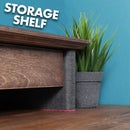Introduction: Simple DIY Mobile Tool Base
My old bandsaw finally gave up on me and stopped working. The motor wasn't worth the cost of fixing and the bandsaw itself wasn't great so I decided to buy a new one. I went for the Record Power BS350S bandsaw as it was a reasonable price and has great reviews. The base it comes with does the job but it is awkward to move around. I have a very small workshop so I thought making a mobile base would be a much better option.
Materials Used:
- 2x CLS - 63mm x 38mm x 2400mm
- 6mm Plywood
- 18mm Plywood
- Castors
- Pocket Hole Screws
- Wood Screws
- Washers
Tools Used:
Step 1: Make the Frame
I start the project by cutting the CLS to length at the mitre saw. The cut list makes this process simple. I don't have to think too much. I just measure the length I need to cut, mark it and then cut. This cut list is obviously to fit the BS350S but you can adapt it to any size you like.
To join the CLS together I opted to use Pocket Hole joinery. This is done by drilling holes using a Pocket Hole Jig and then fastening the wood together with Pocket Hole Screws. Don't worry if you don't have a Pocket Hole Jig. You can simple join the wood with regular wood screws. Drill a pilot hole first and then fasten the pieces together with screws.
The grey dots represents where the Pocket Holes need to be drilled. I used 64mm Pocket Hole Screws to fasten the joints together. The colour coding should hopefully help show how the pieces go together. Its a simple procedure of screwing the parts together to make the frame.
Step 2: Add the Plywood
With the framework put together its time to cut the plywood to size. I didn't have pieces large enough the cut the top and bottom from one piece but that doesn't matter. I cut the 18mm plywood first at the table saw. The overall size I'm after is 540mm x 360mm. I secured the top and bottom pieces to the frame using regular wood screws. I drilled pilot holes first to prevent the wood from splitting.
Next task was to cut the 6mm plywood to size. I needed one piece at 540mm x 399mm. I also needed 2 pieces at 362mm x 399mm. These pieces will clad the outside of the frame. These also get attached using regular wood screws. The plywood will not only help stop things falling out from the inside of the cart but it will also add a lot of strength to the frame itself. The plywood will prevent the frame from racking and it will stiffen the whole structure up.
Step 3: Make It Mobile
Time to make the base mobile! I got 4 castors that include 2 locking castors. These will be positioned at the front so I can easily lock them and prevent the base from moving. They get secured in the corners using pan head screws and a washer. I used pocket hole screws because they a pan head. The castors have quite a large hole where the screws go so a regular head to a wood screw would just go right through it. Adding a washer helps to prevent this too.
Now to put the bandsaw on the base. If you're moving heavy equipment make sure you lift it safely and always get someone to help you if you can. I secured the bandsaw in place using 100mm screws. These aren't ideal but they will do the job for me. I added a washer to them to help spread the load more evenly and help prevent the head of the screw squeezing through the holes on the base of the bandsaw.
That's the base done. Nice and simple but it does the job. It moves a lot easier now than it did on the original base. I am a little worried about it possibly tipping if I push heavier pieces through my bandsaw. If it does, I can always add some kick out legs to prevent it from tipping. I don't cut large pieces often so its not a big deal for me.
I really hope you found this project useful.

Participated in the
Epilog X Contest













